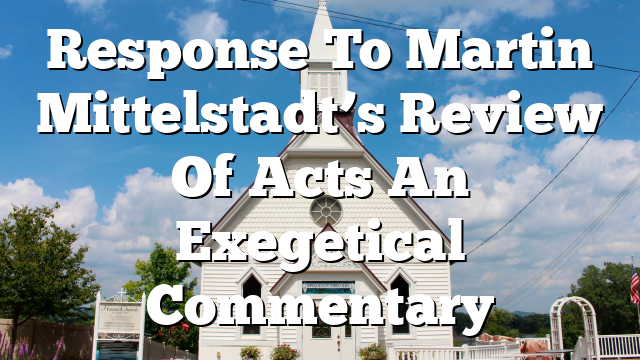Click to join the conversation with over 500,000 Pentecostal believers and scholars
Click to get our FREE MOBILE APP and stay connected
| PentecostalTheology.com



PNEUMA 38 (2016) 207–211
Response to Martin Mittelstadt’s Review of Acts: An Exegetical Commentary
Craig S. Keener
Asbury Theological Seminary, Wilmore, Kentucky
craig.keener@asburyseminary.edu
I am grateful to Professor Mittelstadt for his kind review. Because it is somewhat awkward for me to affirm all his positive comments about my work (ancient rhetoric provided particular rules for “appropriate” boasting), which constitute the majority of his comments, I will focus primarily on points of clarification. Some of these comments reflect our different perspectives, whereas others are points on which we largely agree and are simply matters of emphasis.
I can say, in connection with his favorable remarks, that my thoroughness in my sphere was motivated partly by J.P. Moreland’s invitation, years ago, for evangelicals to produce more “cultural artifacts” that our movement can be proud of. I also hope that global pentecostals will be proud of what is at the moment probably the largest Acts commentary (or possibly single-author commentary of any sort), both in word count and in documentation from ancient sources, and yet reflects a Pentecostal/charismatic ethos and an author whose spiritual experience has been largely shaped in connection with that tradition.
I am grateful for Mittelstadt’s helpful literary suggestions. Although I share his concern for narrative and literary interpretation, he has devoted more con- certed attention to this specific approach and often offers helpful insights that I missed. At the same time, I do not want anyone to come away with an impres- sion (not suggested by Mittelstadt himself) that I did not attend to literary motifs in Luke-Acts as a whole; as even a cursory examiner of my Scripture index may recognize, I engaged Luke’s Gospel at great length (admittedly by cross-references, but often in connection with explanation). Luke’s Gospel con- sumes 64 columns (more than 4200 lines) in my Scripture index, more than any other work (or half-work) indexed except for Acts itself. I have also written commentaries on John and Revelation, but despite my interest in those works, those books, by comparison, earned only nine and eight columns in my index, respectively—less than 15 percent of the citations afforded to the Third Gospel.
© koninklijke brill nv, leiden, 2016 | doi: 10.1163/15700747-03801023
1
208
review essays
I am surprised that Mittelstadt did not find Luke Timothy Johnson’s Acts commentary in my works cited bibliography. Not only is Johnson listed in the bibliography but I cite him hundreds of times; he is one of my primary conversation partners. (By the way, in correspondence Luke Timothy Johnson shared with me that he also has an appreciation for charismatic experience.) I also give attention to Robert Tannehill’s foundational two-volume narrative commentary on Luke-Acts. Of the narrative critics that Mittelstadt cites as particularly important for Luke-Acts, in fact, I engage the works of all but one. Because this is a commentary, however, I engage them primarily in passages where I cite them and not in a methodological introduction (except in some cases for my one introductory chapter on the unity of Luke’s work).
My greater focus on “background” issues, explained explicitly in the intro- duction, stems partly from my own frustration as a young Christian. When reading forty chapters of the Bible a day, I began to readily grasp the literary context, themes running through biblical books, as well as intertextual con- nections with antecedent biblical works and extrinsic connections with other early Christian theology. What I quickly recognized that I lacked, however, was background that biblical authors conspicuously assumed that their audi- ences shared, hence failed to elaborate. (Today, for example, we might think of remarks about 9/11 [referring to the attacks in the usa on September 11, 2001] or “no right turn on red” that would not make sense to a hypothetical reader in 1860 Indonesia.) To illustrate: why did Paul address particular issues in a letter to the church at Corinth (1Cor 1:2) or why Matthew did not need to elaborate on a Jewish custom that Mark deemed to merit explanation (compare Matt 15:1–2 with Mark 7:1–5)? My passion to fill those lacunae in our background knowl- edge has consumed years of enjoyable research, but this is not work I feel needs to be duplicated by everyone else. I had planned to simply go out and preach once I understood the Bible; having already invested years in this work, I made my sacrifices to place the information at others’ fingertips so they can preach and teach without digressing for so many years.
Granted, engaging biblical narrative directly is generally more urgent than engaging its cultural context, but we often presuppose what we assume the latter to be when we frame our understanding of the text. Everyone starts with her or his own cultural assumptions, and those can lead us all to very different ways to hear and appropriate the biblical text. My hope is that once students know how to use narrative method responsibly, they can often implement it on their own, engaging Acts directly; what they typically will continue to lack direct access to without further study is the “background” material. As a scholar who has devoted decades to studying Scripture’s ancient cultural contexts, including reading most of the Loeb Classical Library and most of ancient Jewish
PNEUMA 38 (2016) 207–211
2
review essays
209
literature, I wanted to make my contribution there and relieve others, with other callings, of the extra labor.
I agree that theme-based works are valuable; I believe that monographs are normally better for treating themes than are commentaries, since it would expand the length of the commentary too much to treat a theme again every time that it occurs. Instead, I try to address a theme more extensively in a given passage and then refer the reader to that treatment when the theme arises in other passages.
AsMittelstadtimplies,the lack of pageindicatorsfor moredetailed subhead- ings in the table of contents was not my doing; I nevertheless share his regret concerning it. Although it was a typesetting issue outside my control, I regret even more that the commentary lacks more specific headings at the top of the page. One should, however, be able to locate most of the excurses by using the subject index, which is fairly brief.
Although readers could get lost in the details, I tried to organize the work in such a way that readers could easily map their location and find what they need. I borrow here my words from a response I wrote to some other recent reviewers (not all as affirming as Mittelstadt): “Concerns that the central point of paragraphs get lost in the details depend on how one chooses to use the com- mentary. I include summaries, usually a paragraph each, of my argument at the beginnings of sections and subsections … Thus a reader without time or inter- est to engage all the details on a given passage could simply read these para- graphs fairly quickly. Indeed, were these paragraphs extracted, one should have a fairly concise narrative commentary on Acts. I simply take for granted that long-term readers know how to extract key points by skimming introductions, conclusions, and headings. Those without the patience to turn several pages between summaries are of course welcome to use shorter commentaries.”1
Among points of agreement that nevertheless may invite comment, Mittel- stadt notes my defense of miraculous accounts in Acts. This long chapter in the Acts introduction may be of special interest to our fellow readers of Pneuma, at least those who have not read my much longer work on miracles. My own charismatic experiences (not least tongues and prophecy) and those of oth- ers close to me also helped inform my understanding of and appreciation for charismatic experiences in Acts, as well as being shaped by those experiences described in Acts.
Mittelstadt notes that he cannot require his students to acquire all four volumes for Acts courses. I concur; I do not make my PhD students in my
1 Craig S. Kenner, “A Response to Friends’ Responses,”Trinity Journal37 n.s. (2016): 79–94.
PNEUMA 38 (2016) 207–211
3
210
review essays
Acts seminar buy all four volumes either (though there are some distributors online where they can currently acquire new copies at a significant discount). A commentary is a reference work, and I would not make my students try to read the entire work in one semester. I couple volume 1, with its introduction (and commentary up through the outpouring of the Spirit in Acts 2), with a different commentary and then student presentations summarizing various relevant monographs.
Mittelstadt also notes “sadly” that many pastors will “not take the time to” read through this detailed work. If I may encourage my brother here not to be sad: the book is not written for busy pastors, though some particularly diligent pastors have been working their way through it, but for academic work. I wanted the equivalent of a dissertation of material on each chapter of Acts so that it would be useful for further scholarship. Nevertheless, if one surveys the introductory paragraphs of each section and subsection (anything with a heading or subheading), one will get a summary of the commentary fairly easily, including my insights about the meaning of the narrative as well as many key points of background.
More relevant for the special contribution of the work, which we agree involves the social-historical background of Acts, the 2014 revision of my ivp BibleBackgroundCommentaryincludes a bare-bones, passage-by-passage sum- mary of all my most important background information on Acts, condensed down to about 100 pages. That commentary for the entire New Testament costs only half the price of a volume of my Acts commentary, and is more directly use- ful for busy pastors who need direct access to background (if they can endure this more concise work’s brevity of treatment and lack of exhaustive documen- tation).
Mittelstadt suggests, “These excurses could easily become a standalone background work on early Christianity.” This is not a bad idea, but the work would need to be heavily supplemented because the excurses do not treat every sort of background issue of importance. Nevertheless, some introductions to sections include further background topics, so if some of this material is even- tually developed for further projects, Mittelstadt will merit some of the credit for his suggestion!
Mittelstadt also suggests, “Though [Keener’s] publications continue to mul- tiply, I think it is relatively safe to argue that thirty years of research on the series at hand make this his most monumental work to date.” Since this work consumed my forties, it is relatively safe to omit “to date” and leave this as my most monumental work. I am now in my fifties, when one must conserve one’s decades more sparingly. He jokingly suggests, “I wonder if Keener is ready to work for another twenty years on the prequel?” I can only reply in tradi-
PNEUMA 38 (2016) 207–211
4
review essays
211
tional Pauline idiom, “May it never be!” (nasb), “God forbid!” (kjv, asv), “By no means” (nrsv), or, most colloquially, “No way!” (csk). I thank again Prof. Mittelstadt for a fine and kind review.
PNEUMA 38 (2016) 207–211
5




Most Talked About Today